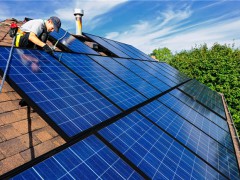據路透社2022年12月21日報道,美國和加拿大的天然氣產量預計在2023年將創下新紀錄,但由于需求疲軟、管道瓶頸和缺乏新的液化天然氣出口工廠,增長速度可能會放緩。
在歐洲的主要天然氣供應不足以后,全球天然氣需求激增,美國和加拿大預計在未來幾年將在高價格的推動下滿足巨大的出口需求。兩國在2022年的天然氣日總產量已達到創紀錄的1160億立方英尺。
美國已經成為歐洲最重要的天然氣來源之一,在爆發地緣政治沖突以后,美國向歐洲提供了重要的能源安全。
美加兩國明年的天然氣產量增長可能會比近幾年慢。由于缺乏將天然氣輸送到主要市場(包括美國墨西哥灣地區的出口終端)的管道,兩國的主要生產氣田的產量都受到了限制。加拿大正在建設一個出口液化天然氣的大型終端,但建成還需要兩年時間。
美國最大的管道公司之一的威廉姆斯公司首席執行官艾倫?阿姆斯特朗表示:“不是產量跟不上,只是基礎設施的限制。”“我們將經歷一段時間,天然氣生產將受到一些限制。”
美國和加拿大今年增加的天然氣產量大部分來自位于得克薩斯州西部和新墨西哥州東部的二疊紀盆地等地區的石油生產伴生的天然氣。
瓶頸限制產出
根據美國能源部公布的數據,2023年美國天然氣日產量預計將增至1004億立方英尺,比2022年增長2%。根據挪威著名能源咨詢公司雷斯塔能源公司公布的數據,加拿大天然氣日產量有望在2022年達到創紀錄的180億立方英尺,2023年達到創紀錄的190億立方英尺。
根據美國聯邦政府的預測,位于阿肯色州、路易斯安那州和得克薩斯州的海恩斯維爾盆地的天然氣產量在過去5年里每年增長超過20%,并有望在2022年增長大約10%。
但持續的天然氣產量增長依賴于建設更多的管道,以免這些盆地像阿巴拉契亞盆地那樣受到限制。阿巴拉契亞盆地是美國最大的頁巖氣產區,位于賓夕法尼亞州、俄亥俄州和西弗吉尼亞州。
由于產量的快速增長,加拿大的天然氣管道也受到了限制,尤其是TC能源公司的NGTL管道系統,該系統將天然氣輸送到加拿大西部地區。
今年8月,由于NGTL管道系統維護造成的瓶頸,艾伯塔省的天然氣價格一度轉為負值。TC能源公司正在擴大該系統以提高天然氣產量。
不斷增長的LNG出口需求
從2017年到2021年,美國液化天然氣出口平均每年增長96%,但預計這一增長速度將放緩,這是因為2023年美國將沒有新的液化天然氣出口終端投入使用。
據美國聯邦政府估計,美國液化天然氣日出口量預計在2022年將達到106億立方英尺,2023年將達到123億立方英尺。一旦得克薩斯州自由港液化天然氣工廠恢復生產,美國液化天然氣出口量可能會在2023年上升。自6月份發生火災以來,自由港液化天然氣工廠已經關閉了幾個月。至少有兩個新的美國液化天然氣出口工廠預計將在2024年投入使用。
能源研究公司East Daley分析副總裁Rob Wilson表示:“伴生氣產量的增長將導致明年美國天然氣供應過剩,因為在2025—2030年新的液化天然氣出口工廠投入使用之前,我們看不到同樣的需求增長。”
伍德麥肯茲分析師Dulles Wang表示,如果加拿大的天然氣產量上升,殼牌公司牽頭的加拿大液化天然氣項目預計將從2025年開始發貨,這可能會壓低價格。
分析師預計,2023年美國路易斯安那州亨利中心基準天然氣價格平均為5.19美元/百萬英熱單位,低于目前的5.39美元/百萬英熱單位。
李峻 編譯自 路透社
原文如下:
US, Canada Natural Gas Output Could Feel Growing Pains In 2023
U.S. and Canadian natural gas production is expected to hit new records in 2023, but growth may be slow due to weakened demand, pipeline bottlenecks and a lack of new LNG export plants.
Gas demand surged worldwide after Europe's primary supply cutting, and the United States and Canada are expected to feed copious demand for exports in coming years, bolstered by high prices. The two countries produced a record combined 116 billion cubic feet per day (Bcf/d) in 2022.
The United States has become one of Europe's most important sources of gas, providing essential energy security after the war.
Next year's growth could be slower than recent years. Major production fields in both countries are inhibited by a lack of pipelines to move gas to key markets, including export terminals in the U.S. Gulf. Canada is in the midst of building a large terminal to export LNG, but its completion is two years away.
"It’s not production that can’t keep up, it’s just simply infrastructure constraints," said Alan Armstrong, chief executive of Williams Cos, one of the biggest U.S. pipeline companies. "We’re going to go through a period here where production is going to be a little bit constrained."
Much of U.S. and Canadian gas output increases this year came from gas associated with oil production in places like the Permian in West Texas and eastern New Mexico.
Bottlenecks Constrain Output
U.S. gas output is expected to rise to 100.4 Bcf/d in 2023, up 2% from 2022's level, according to U.S. energy data. Canadian gas production is on track to reach a record 18 Bcf/d in 2022 and 19 Bcf/d in 2023, according to energy consultancy Rystad Energy.
Output in the Haynesville, located in Arkansas, Louisiana and Texas, and the Permian has increased more than 20% annually over the past five years and was on track to rise about 10% in 2022, according to federal forecasts.
But continued growth depends on building more pipelines, lest those basins become constrained like Appalachia, the biggest U.S. shale gas region in Pennsylvania, Ohio and West Virginia.
Pipelines are also constrained in Canada due to swift production growth, particularly TC Energy Corp.'s NGTL pipeline system that ships gas around and out of western Canada.
In August, gas prices in Alberta briefly turned negative because of bottlenecks stemming from NGTL maintenance. TC Energy is expanding the system to boost flows.
Growing LNG Export Demand
From 2017 to 2021, U.S. LNG exports rose by an average of 96% annually, but that pace is expected to slow with no new U.S. terminals set to open in 2023.
U.S. LNG exports are expected to reach 10.6 Bcf/d in 2022 and 12.3 Bcf/d in 2023, according to federal estimates. Exports could rise in 2023 once Freeport LNG's plant in Texas returns to service. It has been closed for several months since a fire in June. At least two new U.S. LNG export plants are expected to enter service in 2024.
"Growth in associated gas will cause an oversupply of gas going into next year because we don't see the same growth in demand until new LNG export plants enter service in the 2025-2030 time frame," said Rob Wilson, vice president of analytics at energy research firm East Daley.
If Canadian output rises in anticipation of future shipments from the Shell-led LNG Canada project starting in 2025, it could depress prices, Wood Mackenzie analyst Dulles Wang said.
Analysts expect gas prices at the U.S. Henry Hub benchmark NG-W-HH-SNL in Louisiana to average $5.19 per MMBtu in 2023, down from the current $5.39.
免責聲明:本網轉載自其它媒體的文章及圖片,目的在于弘揚石化精神,傳遞更多石化信息,宣傳國家石化產業政策,展示國家石化產業形象,參與國際石化產業輿論競爭,提高國際石化產業話語權,并不代表本網贊同其觀點和對其真實性負責,在此我們謹向原作者和原媒體致以崇高敬意。如果您認為本站文章及圖片侵犯了您的版權,請與我們聯系,我們將第一時間刪除。







